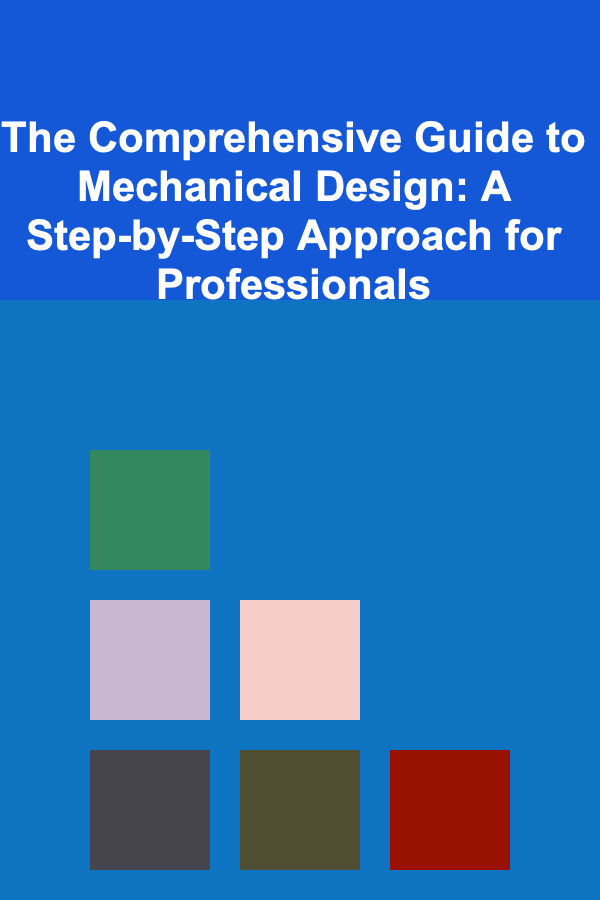
The Comprehensive Guide to Mechanical Design: A Step-by-Step Approach for Professionals
ebook include PDF & Audio bundle (Micro Guide)
$12.99$5.99
Limited Time Offer! Order within the next:

Mechanical design is a critical component of engineering, blending creativity, technical knowledge, and precision to produce functional, efficient, and innovative products. Whether you're designing machinery, consumer products, or complex systems, the principles of mechanical design remain largely the same. This comprehensive guide takes you through a step-by-step approach, offering actionable insights and practical strategies to master mechanical design.
Understanding the Basics of Mechanical Design
Before diving into the intricacies of mechanical design, it's essential to grasp the fundamental principles that underpin this field.
What is Mechanical Design?
Mechanical design refers to the process of creating and optimizing mechanical systems, components, and devices. It involves the application of engineering principles to develop solutions that meet specific requirements, considering factors like performance, cost, manufacturability, and safety.
Key Principles of Mechanical Design
- Functionality: The design must fulfill its intended function efficiently and reliably.
- Ergonomics: The design should be user-friendly, comfortable, and easy to interact with.
- Material Selection: Choosing the right materials ensures durability, cost-effectiveness, and weight considerations.
- Sustainability: Modern mechanical design increasingly focuses on minimizing environmental impact, incorporating energy-efficient solutions, and using sustainable materials.
- Manufacturability: The design must be feasible to produce with the available technology and resources.
Defining the Problem
The first step in any mechanical design process is understanding the problem you're solving. A successful design starts with clear, defined requirements.
1.1 Understanding Stakeholder Needs
A design begins with the needs of stakeholders---whether they are customers, project managers, or other engineers. Often, the first step is to gather detailed input from stakeholders to understand the function, constraints, and goals of the project.
- Ask Questions: What problem are you solving? Who are the end-users? What are the budget constraints? What performance metrics are essential?
- Research: Look at existing solutions and technologies that might inform your design process. Identify any gaps or limitations in current offerings.
1.2 Creating a Problem Statement
Once you've gathered your information, formalize a clear and concise problem statement that outlines what the design should achieve. The statement should cover:
- The primary objective: What is the device or system meant to do?
- Constraints: Consider size, weight, material, cost, and time limitations.
- Desired outcomes: Specify the performance metrics or functionality levels expected.
Conceptualization and Ideation
With a clear understanding of the problem, the next phase is conceptualization. This stage is all about brainstorming and generating various design solutions.
2.1 Brainstorming Ideas
There's no such thing as a bad idea during brainstorming. Use techniques like:
- Mind Mapping: To explore related concepts and visualize the connections between ideas.
- Sketching: Quick, rough sketches allow you to explore different shapes, configurations, and components.
- Collaborative Discussions: Include colleagues or experts from different disciplines to bring fresh perspectives to the design challenge.
2.2 Evaluating Feasibility
Once you have a variety of ideas, evaluate each one for feasibility. This includes:
- Technical feasibility: Can the design be built with current technologies and manufacturing processes?
- Cost feasibility: Will the design be affordable to produce, considering material, labor, and other costs?
- Performance feasibility: Will the design meet the required performance metrics?
2.3 Prototyping Early Concepts
Prototypes are crucial for testing ideas in the real world. By creating low-fidelity models or mock-ups of your concepts, you can explore how they function and get immediate feedback from stakeholders.
- Physical Models: Build basic prototypes to test form, fit, and function.
- CAD Models: Computer-aided design (CAD) tools allow you to simulate and iterate on the design virtually before moving to the physical model.
Detailed Design and Engineering
Once a concept has been selected, it's time to begin detailed design, where engineering principles come into play to refine the product's specifications.
3.1 Choosing Materials and Components
Material selection is critical to the success of your design. The material you choose affects the durability, cost, weight, and manufacturing complexity of the product.
- Strength and Durability: Ensure that the material can handle the stress and strain expected during its lifetime.
- Corrosion Resistance: Consider the environment the product will operate in---e.g., exposure to moisture, chemicals, or extreme temperatures.
- Weight and Cost: Choose materials that balance performance with weight and cost constraints.
3.2 Performing Calculations and Simulations
Engineers rely on calculations and simulations to predict how their designs will behave under real-world conditions. These tools can include:
- Stress Analysis: Use finite element analysis (FEA) tools to predict how materials will deform and where they might fail under load.
- Thermal Analysis: Simulate heat transfer and temperature distribution within the system, especially if the design involves high-temperature operations.
- Dynamic Analysis: Evaluate how moving parts interact with each other, particularly in machinery and mechanical systems.
3.3 Tolerances and Manufacturing Constraints
Engineering design must consider manufacturing capabilities. This includes understanding how parts will be fabricated and what tolerances are acceptable.
- Tolerance Analysis: Ensure that parts fit together properly, and that the manufacturing process will be able to create parts within the desired tolerance ranges.
- Cost-effective Manufacturing: Choose processes that are suitable for your product's volume and complexity---whether injection molding, 3D printing, or CNC machining.
Prototyping and Testing
After refining the design, it's time to produce a prototype and conduct real-world tests. This phase is vital for verifying that the design works as intended.
4.1 Building the Prototype
Depending on the complexity and stage of the design, you may use various techniques for building a prototype:
- Rapid Prototyping (3D Printing): For early-stage designs, 3D printing can produce quick, functional models.
- Low-Volume Production: In some cases, it might be necessary to create prototypes using the actual manufacturing process.
4.2 Testing and Iteration
Once the prototype is ready, it's time to test it. Testing should assess whether the prototype meets the requirements defined in the problem statement.
- Functional Testing: Does the prototype perform as expected?
- Stress Testing: Does it withstand operational stresses without failure?
- Usability Testing: If applicable, is the product intuitive and easy to use?
Iterate on the design based on test results, identifying areas for improvement and refining the prototype until the design is optimized.
Final Design and Production
After extensive testing and iteration, the design reaches its final form, ready for production. The final design must include:
5.1 Creating Detailed Drawings and Documentation
Create comprehensive drawings that detail every aspect of the design, including:
- Assembly Drawings: Illustrate how all the components fit together.
- Part Drawings: Show individual components with dimensions and tolerances.
- Bill of Materials (BOM): A list of materials, parts, and components needed for manufacturing.
These drawings ensure that the product can be manufactured accurately and cost-effectively.
5.2 Production Planning
Work closely with manufacturers to ensure that the final design can be produced efficiently. This includes:
- Supply Chain Management: Identifying and securing the necessary materials and components.
- Quality Control: Establishing procedures to ensure that the final product meets the design specifications.
- Manufacturing Scheduling: Coordinating production timelines to meet deadlines.
5.3 Testing the Final Product
Once the product is manufactured, conduct a final round of testing to verify that everything works as intended. This may involve:
- Quality Assurance: Checking for defects or imperfections in the final product.
- Performance Testing: Verifying that the product performs within the expected parameters.
Conclusion
Mechanical design is a dynamic, iterative process that requires a combination of creativity, technical knowledge, and practical skills. From understanding the problem to the final product's delivery, the key to successful mechanical design lies in attention to detail, rigorous testing, and continuous iteration. By following this step-by-step approach, you can ensure that your designs are functional, efficient, and ready for real-world applications.
Whether you're designing everyday products or complex machinery, mastering the principles of mechanical design will not only improve the products you create but also sharpen your skills as an engineer, making you a more effective and innovative problem solver in the field.
Reading More From Our Other Websites
- [Home Party Planning 101] How to Plan a Themed Costume Party at Home
- [Trail Running Tip 101] Best Eco‑Friendly Trail Running Apparel for Sustainable Athletes
- [Home Maintenance 101] How to Prevent Mold and Mildew Growth in Your Home
- [Organization Tip 101] How to Designate Spaces for Different Activities in Your Yard
- [Organization Tip 101] How to Set Reminders for Regular Home Maintenance Tasks
- [Home Security 101] How to Use a Home Safe to Protect Valuables
- [Personal Care Tips 101] How to Perform a Self-Massage for Lymphatic Drainage Massage: Benefits and Techniques
- [Home Party Planning 101] How to Plan a Stress-Free Holiday Cookie Exchange
- [Metal Stamping Tip 101] Optimizing Tool Paths: Reducing Cycle Times in CNC-Driven Metal Stamping Operations
- [Mindful Eating Tip 101] From Fast Food to Fast Calm: Transforming Meals Into Stress‑Busting Rituals

How to Build a Checklist for Natural Disaster Preparedness
Read More
How to Clean Your Home Without Using Disposable Products
Read More
How to Handle Moving Difficult Items Like Pianos or Artwork
Read More
How to Organize Digital Memories for a Virtual Time Capsule
Read More
How To Develop a Strong Business Network
Read More
How to Train Your Badminton Mental Toughness
Read MoreOther Products

How to Build a Checklist for Natural Disaster Preparedness
Read More
How to Clean Your Home Without Using Disposable Products
Read More
How to Handle Moving Difficult Items Like Pianos or Artwork
Read More
How to Organize Digital Memories for a Virtual Time Capsule
Read More
How To Develop a Strong Business Network
Read More